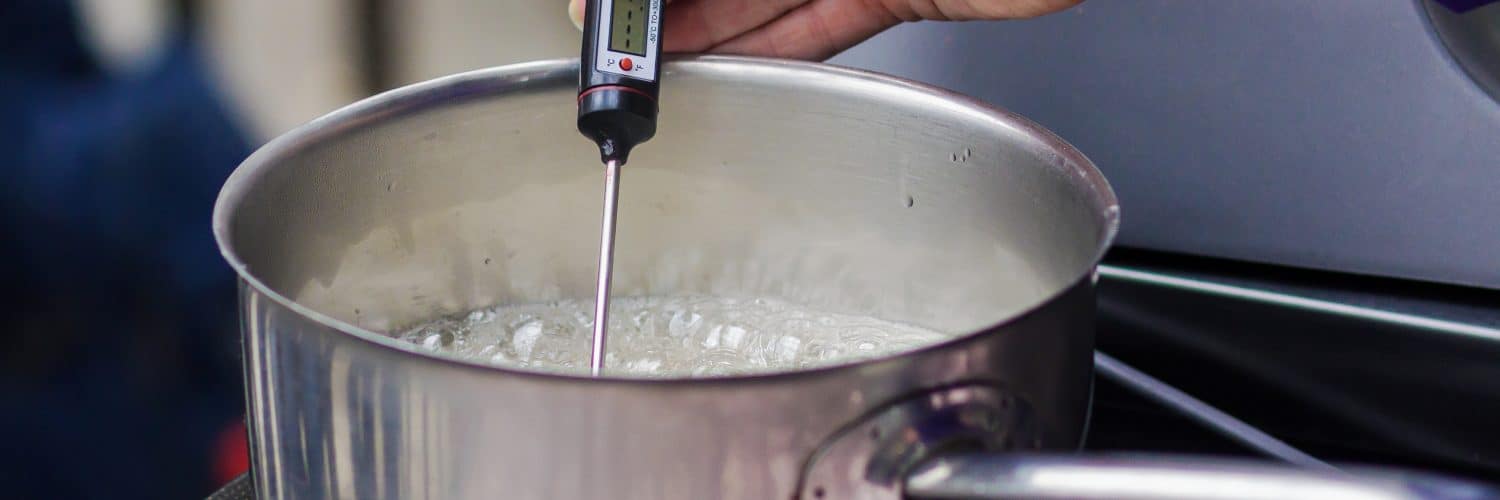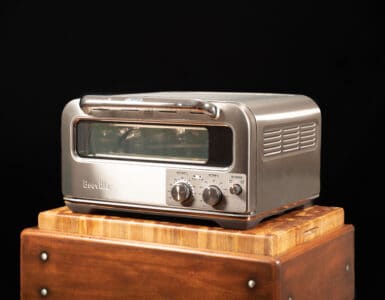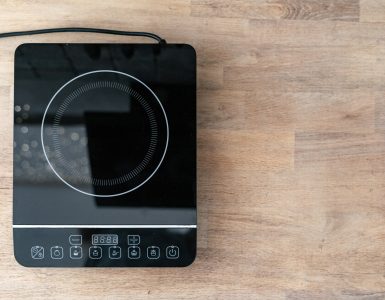This page may contain affiliate links. If you make a purchase through one of these links, we may earn a commission at no extra cost to you.
Before we begin: if you just want the quick answer as to which is our top pick for the best candy thermometer, it’s the CDN DTC450. Despite its somewhat uninviting name, this is an intuitive, easy-to-use, and high-quality thermometer specifically designed for candy.
When you’re making candy, knowing its precise temperature at any given time is vitally important. This isn’t like some other foods, where being off by 10° F or so isn’t a big deal. In fact, it’s just a 10° difference between the upper end of soft crack and the lower end of hard crack, which can be a dramatic difference in the final texture and snap of your candy.
With that level of precision involved in the candy-making process, it’s absolutely vital that you use an accurate thermometer. That’s why we’ve compiled this list of the best candy thermometers, to help you choose one that’s right for you! While various details differ between these thermometers, accuracy is the one trait we weren’t willing to compromise on.
Table of Contents
7 Best Candy Thermometers at a Glance
Best for: digital thermometer specifically made for candy
Best for: making large batches of candy
Best for: affordable glass thermometer
Best for: instant-read thermometer
Best for: traditional analog model
Best for: the gadget-loving home cook
Best for: extreme budget
The Top 7 Candy Thermometers
#1. CDN DTC450 Digital Candy/Deep Fry Thermometer
Best for: digital thermometer specifically made for candy
Our top pick for a candy thermometer, the CDN has just about everything you could want. And, while this thermometer is also capable of working as a frying thermometer, it’s clear that this tool was designed with the candy-maker in mind.
The CDN has a clip so that you can attach it onto your pan, so it will continually measure the rising temperature of your candy as you cook it. (You’d be surprised by how many candy thermometers don’t have this vital feature!)
This thermometer has handy preset temperatures corresponding to the common candy stages, which is seriously useful if you don’t have your candy temperatures memorized. The thermometer will then beep when the temperature reaches a couple of degrees below the chosen temperature. (Yes, you can choose your own temperature too, you don’t need to use one of the presets.)
We also appreciate the dual display, which shows both the current temperature of your candy as well as the goal temperature that you set, whether you selected it yourself or used one of the preprogrammed options.
Our only real issue with this thermometer is that the display can become difficult to read as it reaches higher temperatures. Making sure you remove the film from the screen can help reduce this issue, but may not fully resolve it. Other than that detail, we love this thermometer and recommend it despite the relatively high price tag.
Specs and Features
- Measuring method: digital
- Clip to pan: yes
- Maximum temperature: 450° F
#2. Taylor Precision Candy & Deep Fry Thermometer
Best for: making large batches of candy
If you prefer an old-school style over new digital displays, this may be the thermometer for you. It uses a glass tube full of alcohol (not mercury, don’t worry!) to measure the temperature of your candy.
One of the most appealing features about this thermometer is that it has the five major candy temperatures printed on its face, so you can immediately see how your temperature compares to the final consistency you’re going for. You’ll see soft ball, firm ball, hard ball, soft crack, and hard crack all printed on the front of the thermometer.
We also love the adjustable pan clip. Instead of trying to find a pot that will bring your candy to the right height for the thermometer, you can simply adjust the clip on the thermometer to make it the right height for the pan.
With that said, be aware that this is a large thermometer that needs to be immersed at least 2 1/2” deep into your candy mixture without touching the bottom of the pot. In other words, it’s best for large batches of candy. In fact, the temperature readings may be inaccurate if you try to use it with a batch that’s too small, since you can’t immerse it far enough and it may make contact with the pan. If you tend to make large batches, this won’t be a problem! But if you make smaller batches of candy, look elsewhere.
Specs and Features
- Measuring method: glass
- Clip to pan: yes
- Maximum temperature: 400° F
#3. Polder Candy/Jelly/Deep Fry Thermometer
Best for: affordable glass thermometer
Similar to the Taylor in style, the Polder thermometer is also equipped with the common candy temperatures written on its face. This helps you keep track of exactly how much hotter your mixture needs to get before you can proceed to the next step. For this one, the listed stages are thread, soft ball, hard ball, soft crack, hard crack, and fry.
The big difference is that this one doesn’t need to be immersed quite as deeply. If you tend to make smaller batches of candy (or at least want the option of doing so), you’ll appreciate only needing to immerse this one 1 1/2” to 2” deep, which can be quite a difference in volume depending on the size of your pot!
Its price is generally similar to that of the Taylor, but at the time of writing, it’s available for an incredible sale price. Due to Amazon’s terms of use, I’m not allowed to list the exact price here. But as you’re shopping, it’s worth checking on the Polder to see if you can catch it when it’s on sale too. If so, you’re getting a great deal on a reliable and accurate tool.
Specs and Features
- Measuring method: glass
- Clip to pan: yes
- Maximum temperature: 400° F
#4. Lavatools PT12 Javelin Digital Instant Read Thermometer
Best for: instant-read thermometer
First things first: this thermometer is not specifically designed for candy. That’s not to say it doesn’t work (it’s on our list, after all!), but it’s important to understand that candy isn’t its primary intended purpose.
This is most obvious in the fact that candy thermometers are generally designed to stay in the cooking pot, constantly monitoring your candy’s temperature so you don’t accidentally take it to the next stage.
This thermometer, on the other hand, allows you to get a quick reading at any time but doesn’t stay in the pan. Instead, you just turn it on and stick the tip of the probe into your hot candy whenever you want to check on it. The potential risk there, of course, is that you forget to check for a while and end up overcooking your candy.
So why is it on our list? Several reasons! First, it’s accurate to under a degree, which is a fantastic level of precision. Also, the fact that it’s not specifically a candy thermometer is actually a strength if you cook anything else in the kitchen; you can use this for all sorts of purposes that a glass-style candy thermometer wouldn’t work for. Plus we love the quick readout, which lets you get a temperature measurement in just seconds.
Writer’s note: I personally have and love this thermometer. In fact, I like it so much that I kept it after reviewing it for Cuisine Technology. You can read my full review of the Lavatools Javelin here for more details about it!
Specs and Features
- Measuring method: digital
- Clip to pan: no
- Maximum temperature: 482° F
#5. Escali AHC1 Candy/Deep Fry/Confection Thermometer
Best for: traditional analog model
Why change what works? If you feel like you’ve seen this thermometer before (maybe several decades ago), that’s just a testament to its classic design and ability to stand the test of time.
One of the great things about this thermometer is that the face shows not only at what temperature you reach each candy stage, but also the entire range of each stage. That is, it shows that hard crack is from 300° F to 310° F instead of just telling you that you’ve reached this stage when you get to 300° F.
Since its face is a flat circle, it’s also easier to view than some other options. You can simply look down at the pot to see it instead of straining to get a half-sideways view the way you need to with some others.
This thermometer, which simply clips onto your pot, doesn’t have the bells and whistles of some of the newer designs. It won’t beep when it’s approaching your target temperature, for example. But it has an adjustable marker that you can slide to your desired temperature to help you quickly and easily see how close you’re getting.
For traditionalists who don’t want a digital candy thermometer, the only real drawback of this device is that it needs to be calibrated. This is pretty simple and straightforward to do, but be aware that you’ll need to deal with that when you get it rather than using it straight out of the box.
Specs and Features
- Measuring method: analog
- Clip to pan: yes
- Maximum temperature: 500° F
#6. Lightbeam Digital Candy Thermometer
Best for: the gadget-loving home cook
If our previous pick, the Escali, is all about traditional style, this one is completely on the other end of the spectrum. It’s innovative almost to the point of absurdity, challenging you to ask yourself the question, “Do I really need that?”
If your answer to that question is an enthusiastic “yes!”, then this is the thermometer for you, because it’s definitely unique. If you’re the creative cook whose kitchen is full of innovative and entertaining gadgets that none of your friends have ever even heard of, this might be the thermometer that you would have dreamed of (if you knew it existed).
But let’s be serious. In addition to being a fun novelty item, this spatula-meets-thermometer is surprisingly functional, too. Just think: you’ll be able to stir and measure your candy or melted chocolate all at once. And the probe thermometer comes out of the spatula, meaning you can use it for meats or other foods as well.
All in all, this is a fun novelty tool that may be the right pick for you in specific circumstances. In particular, it may be ideal for the fun-loving home cook who makes candy occasionally and wants a versatile tool that isn’t restricted to just candy. But if you’re serious about your candy-making or do it often, you’ll probably want to look elsewhere.
Specs and Features
- Measuring method: digital
- Clip to pan: no
- Maximum temperature: 572° F
#7. Taylor Classic Line Candy/Deep Fry Thermometer
Best for: extreme budget
One of the great things about making your own candy is that it’s actually incredibly affordable at its most basic level. With just a few simple, inexpensive ingredients and a pot on the stove, you can make your own hard or chewy candies. And you don’t technically even need a thermometer, because you can use ice water instead if necessary.
However, having a thermometer definitely makes things easier, even if you’re on a tight budget. And that’s why the Taylor is on our list! It’s definitely not one of our favorite options overall, but it’s a fantastic choice if you’re on a tight budget but want to up your candy game.
This simple, straightforward thermometer clips onto the edge of your pot to continually monitor your candy’s temperature. The bad news is that the clip partially obscures the thermometer itself, making it impossible to read whatever part of the range it’s covering.
While the thermometer itself isn’t marked with the temperatures for different candy stages, the case has some basic information. This is somewhat useful, but we wish it offered temperature ranges. Instead, it lists just one temperature for each stage, typically somewhere in the middle of the range.
That is, for hard crack, it doesn’t list 300-310° F (the full range for this stage) or 300° F (the beginning of the stage). Instead, it lists hard crack as 302° F.
In short, if you want a candy thermometer and you’re on an extreme budget, this thermometer should serve you well as long as you’re willing to live with its quirks and do your own research about temperature ranges. But if you can afford to pay a little more for a better one, we would recommend doing that instead.
Specs and Features
- Measuring method: glass
- Clip to pan: yes
- Maximum temperature: 400° F
What Is a Candy Thermometer? And Why You Need One
Making sugar-based candies is surprisingly easy—as long as you get the temperature exactly right. The difference between a chewy candy and a hard one that shatters when you bite it is all about achieving a specific temperature. And while both can be delicious, you’ll probably enjoy your candy even more if it’s the texture you want!
Candy thermometers are specifically designed to help ensure you get exactly the right temperature, meaning your candy will be the consistency you chose.
You don’t absolutely need one; you can drip candy into a container of ice water and observe how it feels when it’s cool. But a thermometer will help you get predictable, consistent, and reliable results every time.
The Different Types of Kitchen Thermometer
Not every kitchen thermometer is a candy thermometer, and it’s important to understand the difference as you’re deciding which to buy!
A candy thermometer is designed to be able to handle high temperatures, and to be partially immersed in liquid. Most candy thermometers are designed with a clip to attach them onto your pot, so they can stay in the candy the whole time and give you a constant reading of the temperature. This allows you to watch the temperature rise and keep a close eye on it so you don’t overshoot and accidentally overcook your candy.
A probe thermometer is more designed for foods that you can actually stick the thermometer into. You may associate these with checking the temperature on a steak or turkey, for example. However, just because something is a probe thermometer doesn’t mean it’s only for meat; “probe” simply refers to the design, which has a sharp probe to sense the temperature. Assuming your probe thermometer can handle high enough temperatures, you can use it to check your candy’s temperature. In most cases, you’ll need to check manually, as most probe thermometers aren’t designed to attach to a pot of candy.
Most instant read thermometers are probe thermometers. Depending on your cooking style, an instant read thermometer may work well for you. You’ll need to check your candy’s temperature often, since these aren’t designed to attach to a pot and do a continuous reading. But since they check the temperature so quickly (usually in just a few seconds), this is pretty easy to do.
There are several other types of kitchen thermometers as well, such as oven thermometers and refrigerator thermometers. However, these aren’t relevant to candy-making, so we won’t go into any depth about those.
Whatever kind of thermometer you choose, make sure it can measure hot enough for candy. Many meat thermometers only go up to 200° F or so, which isn’t nearly high enough for candy. Look for one that goes to at least 350° F (all the options on our list go to at least 400° F).
Do You Really Need a Candy Thermometer?
Nope! You can absolutely make candy without a thermometer. Simply prepare a container of ice water as you’re making your candy.
When you’re ready to check on the candy, drip a little bit into the ice water. Fish it out and feel it, then bite it. This will help you figure out which stage your candy is in, and whether it’s the consistency you were going for.
However, it’s definitely easier and more consistent to use a thermometer as you’re making candy. You’ll know exactly when it reaches the stage you want, and be able to replicate your results time after time.
If you only make candy on a rare occasion or want to make it on a whim, a candy thermometer may not be worth it for you (or you may prefer to get a multipurpose kitchen thermometer that isn’t limited to candy). But if you’re ready to develop a fun new hobby as a confectioner, a candy thermometer will be invaluable.
Conclusion
Making candy should be fun, not stressful. And with a good-quality candy thermometer, it can be! You won’t need to worry about how to tell if your candy is the right temperature, or whether you’ve accidentally overcooked it. Instead, you can focus on all the fun details like the flavor and color.
Which thermometer you should get depends a lot on your own preferences, and there’s no perfect answer that everyone will love. Our list covers all of the main types, giving you an array of great options to choose from. We hope you’ll enjoy your thermometer, and continue making delicious candy for years to come!

















